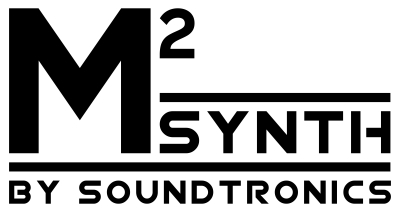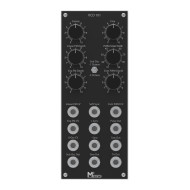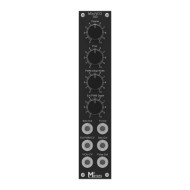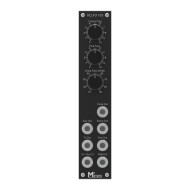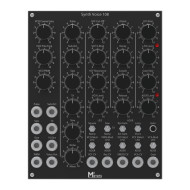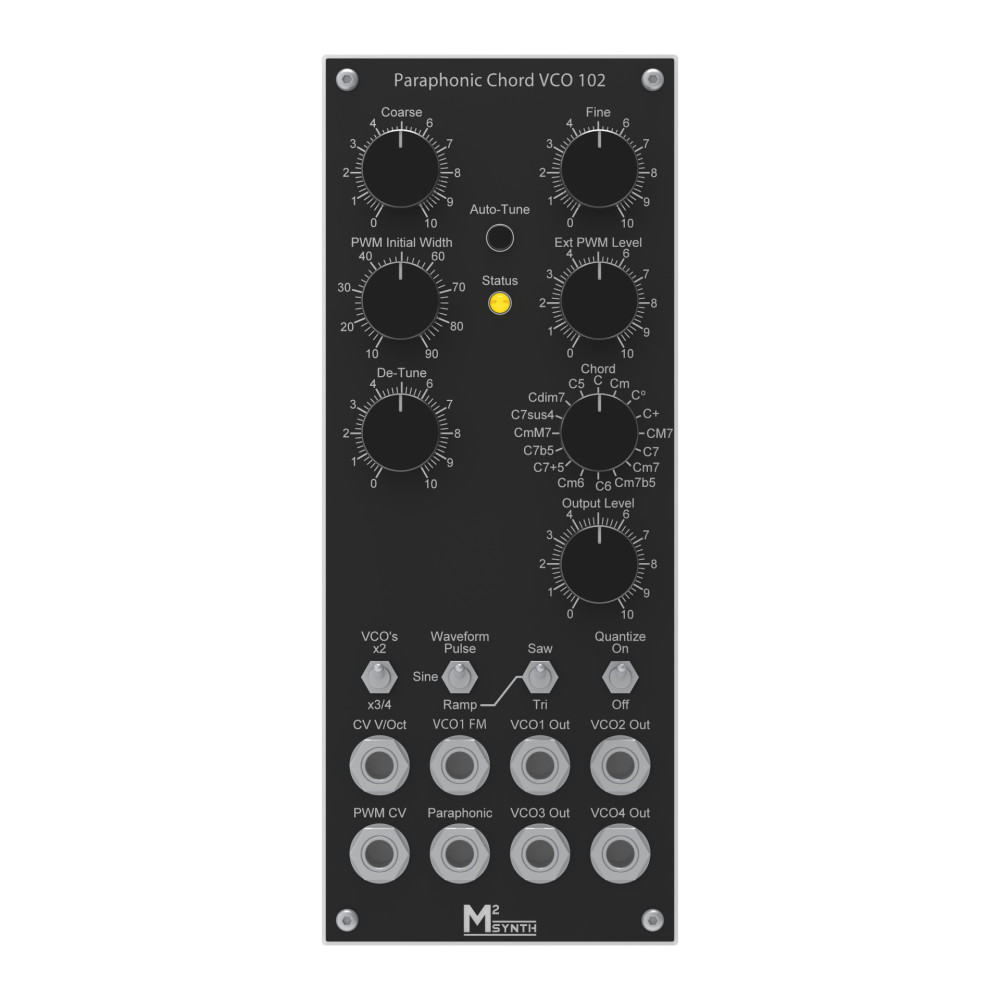
The Chord VCO 102 is similar to the VCO 101 and VCO 103 except that this VCO contains 4 individual VCOs that are controlled in such a way as to produce preset chords.
As with any analogue VCO, they are not precise unlike their digital equivalents but this is often viewed as an advantage. Tuning 4 VCOs to produce chords and keeping them in tune is not so easy. The 102 VCOs each have built in temperature compensation but also have automatic tuning. The automatic tuning is manually initiated and carried out by a microprocessor. The microprocessor will tune each VCO over the entire range of an 88-note piano. Tuning is close to ideal but not absolute to retain a beat frequency between the VCOs.
It is possible to hear the tuning taking place if you so desire.
The chord selector switch allows any one of 16 preset chords, the chords are:
{4,7,0}, Major
{3,7,0}, Minor
{3,6,0}, Diminished
{4,8,0}, Augmented Major
{4,7,11}, Major 7th
{4,7,10}, Dominant 7th
{3,7,10}, Minor 7th
{3,6,10}, Minor 7th Flat 5th
{4,7,9}, Major 6th
{3,7,9}, Minor 6th
{4,8,10}, 7th Sharp 5th
{4,6,10}, 7th Flat 5th
{3,7,11}, Major 7th Flat
{5,7,10}, Dominant 7th Suspended 4th
{3,6,9}, C Diminished 7
{7,12,0}, C5 Power chord
The numbers in the {} indicate the number of semitones above the root note the second, third and fourth VCO frequencies are set. Where the number is a 0, the VCO is muted and does not contribute to the chord. A toggle switch can additionally mute VCO 3 & 4 to leave just the root note (VCO 1) and VCO 2 in the chord.
A detune control forces VCO 2 & 4 frequencies higher and VCO 3 frequency lower without affecting the root frequency of VCO 1. Throughout the detune range, points can be found where the VCOs harmonise for some rather interesting effects.
With the Quantize switch on, the microprocessor will select the note closest to the applied CV to the 1V/Oct input. The Status LED indicates how close the applied CV is to the optimal voltage for a given note. The dimmer the Status LED, the more indeterminate the selection will be. If the CV is linearly raised, the paraphonic output will increment in semitone steps. Taking the CV from the MIDI2CV 140 module should always result in the Status LED being near full brightness irrespective of what note is being played. Use the fine frequency control to initially set the desired note and to set the LED brightness to maximum.
With the Quantize switch set to off, the VCOs will be free running and no longer follow the semitone steps as described above. The frequencies of the VCOs will now closely follow the CV input while still retaining their chord ratios.
Features
- Coarse and fine frequency controls
- 1V Octave CV Input
- Built in Quantizer in semitone steps
- Auto-Tune
- Range - 88 piano notes
- 16 preset chords
- Selectable pulse, sine, saw and tri waveforms
- Each VCO has its own output
- Combined paraphonic output (chord)
- Switch to mute VCO 3 & VCO 4 for 2 note chords
- FM input for VCO 1
- Manual de-tune control
Specification
- Supply voltage +/-12Vdc (note: this modules uses two power supply connectors for load sharing)
- Supply current J9 +26mA / -30mA, J10 +64mA / -37mA
- Waveform levels +/-5V
- PWM CV range 0-10V
- Main PCB dimensions 87.5 x 154.85mm
Available to order, dispatched in 3-4 weeks
